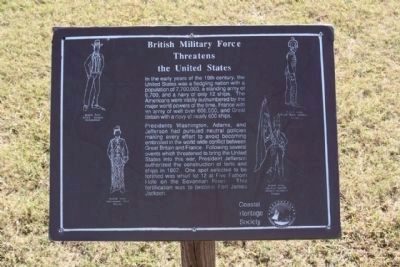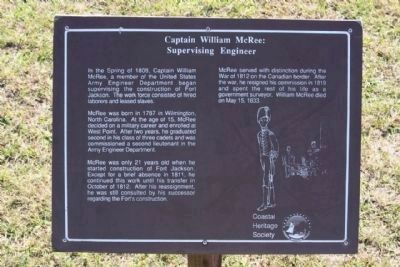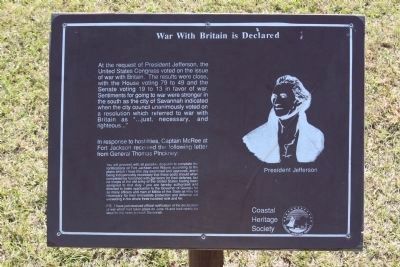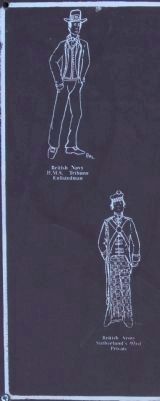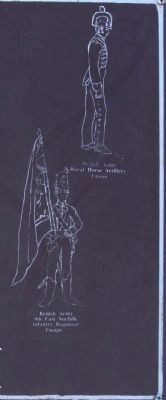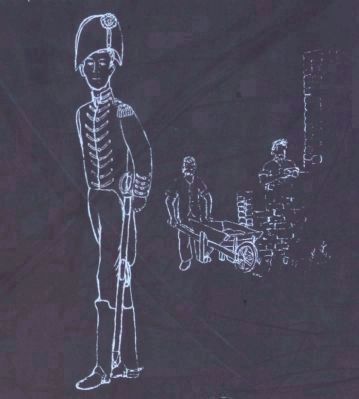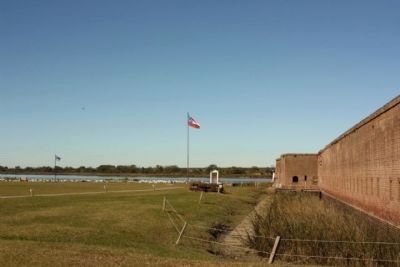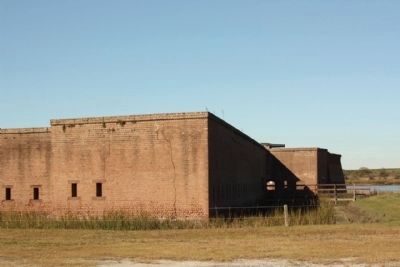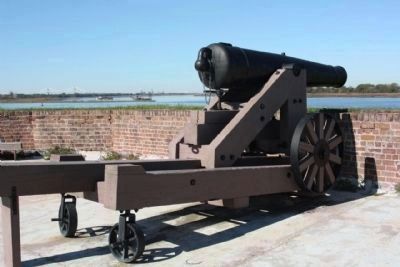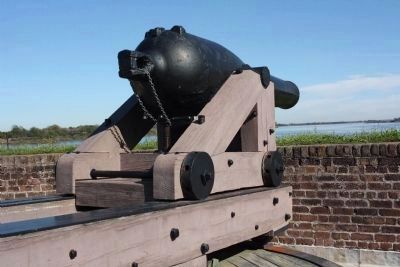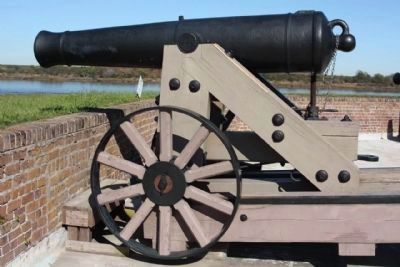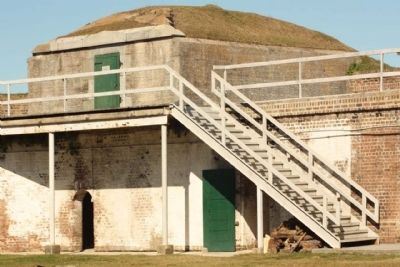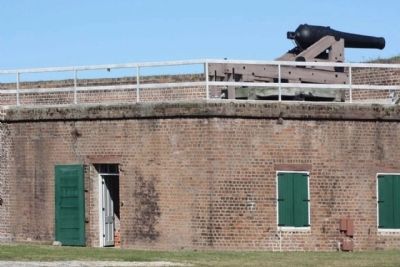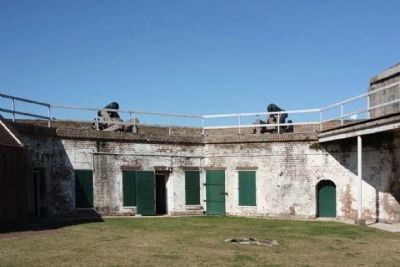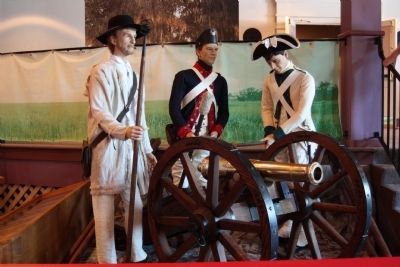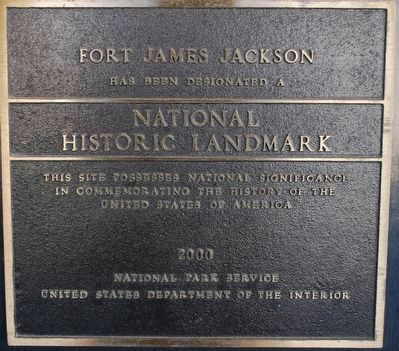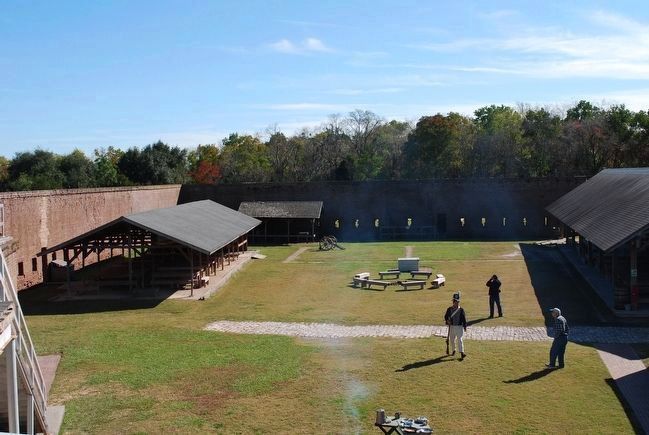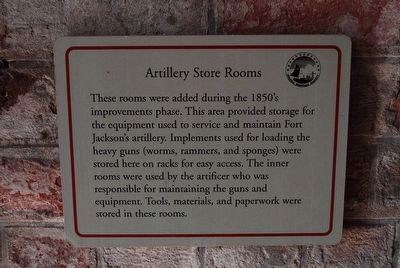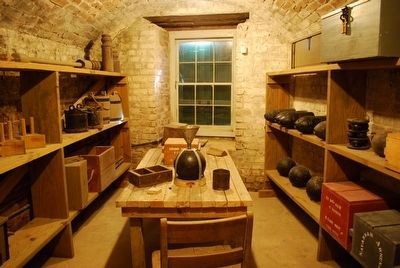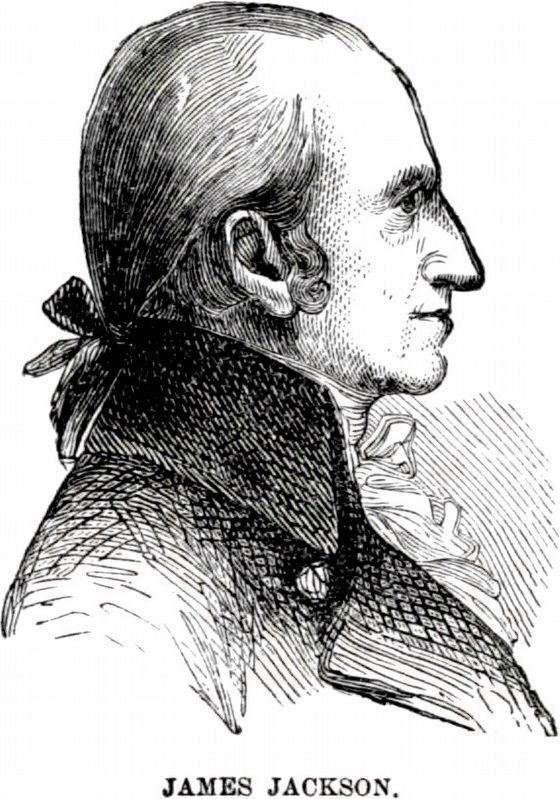Savannah in Chatham County, Georgia — The American South (South Atlantic)
Construction of Fort Jackson
Inscription.
(Panel one)
British Military Force Threatens the United States
In the early years of the 19th century, the United States was a fledgling nation with a population of 7,700,000, a standing army of 6,700, and a navy of only 12 ships. The Americans were vastly outnumbered by the major powers of the time, France with an army of well over 600,000 and Great Britain with a navy of nearly 600 ships.
Presidents Washington, Adams, and Jefferson had pursued neutral policies making every effort to avoid becoming embroiled in the world wide conflict between Great Britain and France. Following several events which threatened to bring the United States into this war, President Jefferson authorized the construction of forts and ships in 1807. One spot selected to be fortified was lot 12 at Five Fathom Hole on the Savannah River. This fortification was to become Fort James Jackson.
(Panel two)
Captain William McRee:
Supervising Engineer
In the spring of 1808, Captain William McRee, a member of the United States Army Engineer Department began supervising the construction of Fort Jackson. The work force consisted of hired laborers and leased slaves. McRee was born in 1787, in Wilmington North Carolina. At the age of 15, McRee decided on a military career and enrolled at West Point. After two years, he graduated second in his class of three cadets and was commissioned a second lieutenant in the Army Engineer Department. McRee was only 21 years old when he started construction of Fort Jackson. Except for a brief absence in 1811, he continued this work until his transfer in October of 1812. After his reassignment, he was still consulted by his successor regarding the Fort's construction. McRee served with distinction during the War of 1812 on the Canadian border. After the war, he resigned his commission in 1819 and spent the rest of his life as a government surveyor. William McRee died on May 15, 1833.
(Panel three)
War With Britain is Declared
At the request of President Jefferson, the United States Congress voted on the issue of the war with Britain. The results were close, with the house voting 79 to 49 and the Senate voting 19 to 13 in favor of war. Sentiments for going to war were stronger in the south as the city of Savannah indicated when the city council unanimously voted on a resolution which referred to war with Britain as "...just, necessary, and righteous..."
In response to hostilities, Captain McRee at Fort Jackson received the following letter from General Thomas Pinckney:
You will proceed with all possible dispatch to complete the fortifications
of Fort Jackson and Wayne according to the plans
which I have this day examined and approved, and it being indispensably
necessary that these posts should when completed be furnished with
garrisons for their defense, but no troops of the old army of the
United States having been assigned to that duty / you are hereby
authorized and directed to make application to the Governor of Georgia
for as many officers and men of Militia of this State as may be
necessary for their immediate protection and defense not exceeding
in the whole three hundred rank and file.
P.S. I have just received official notification of the declaration of war which had taken place on June 18 and took nearly six days for the news to reach Savannah.
Erected by Coastal Heritage Society.
Topics and series. This historical marker is listed in these topic lists: Forts and Castles • Military • War of 1812. In addition, it is included in the Former U.S. Presidents: #01 George Washington, the Former U.S. Presidents: #02 John Adams, and the Former U.S. Presidents: #03 Thomas Jefferson series lists. A significant historical month for this entry is May 1864.
Location. 32° 4.903′ N, 81° 2.233′ W. Marker is in Savannah, Georgia, in Chatham County. Marker can be reached from Fort Jackson
Road. North (left) off of Presidents Street (US80) at Woodcock Street ,east (right) off of Woodcock Street onto Fort Jackson Road, Located at Old Fort Jackson. Touch for map. Marker is in this post office area: Savannah GA 31404, United States of America. Touch for directions.
Other nearby markers. At least 8 other markers are within 3 miles of this marker, measured as the crow flies. Garrison of Fort Jackson (within shouting distance of this marker); Republican Blues (within shouting distance of this marker); Fort James Jackson (within shouting distance of this marker); a different marker also named Fort James Jackson (about 300 feet away, measured in a direct line); CSS Georgia: The "Ladies' Gunboat" (about 300 feet away); 1873 Shell Magazine (about 400 feet away); The Napoleon 12-Pounder Field Gun Model 1857 (about 400 feet away); Colonials at Bonaventure (approx. 2½ miles away). Touch for a list and map of all markers in Savannah.
Regarding Construction of Fort Jackson. Entry on National Register of Historic Places:
Built in the period 1808–1812; defended Savannah and its harbor; used by the Confederacy; withstood a minor Union attack in 1862.
Designated National Historic Landmark:
February 16, 2000
Fort James Jackson (added 1970 - - #70000200)
Also known as Fort Oglethorpe
♦ Historic Significance: Event, Architecture/Engineering
♦ Architect, builder, or engineer:
Unknown
♦ Architectural Style: No Style Listed
♦ Area of Significance: Military, Architecture
♦ Period of Significance: 1850-1874, 1825-1849, 1800-1824
♦ Owner: State
♦ Historic Function: Defense
♦ Historic Sub-function: Fortification
Also see . . . Fort James Jackson. National Historic Landmark Nomination, prepared by Mr. Jefferson C. Reed August 21, 1998. (Submitted on October 7, 2020, by Allen C. Browne of Silver Spring, Maryland.)
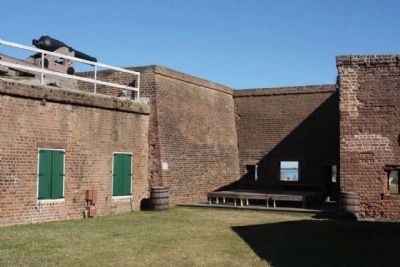
Photographed By Mike Stroud, November 29, 2009
15. Fort Jackson Demi- Bastion
This is one of four "demi-bastions" in
Fort Jackson. They were designed to
protect the Fort's walls by firing into
the flanks or sides of attacking troops.
This demi-bastion had a 32-pounder
cannon on a casemate carriage. It sat
upon a wooden platform. Cannons were
never mounted in the remaining three
demi-bastions.
Credits. This page was last revised on October 8, 2020. It was originally submitted on November 30, 2009, by Mike Stroud of Bluffton, South Carolina. This page has been viewed 1,672 times since then and 44 times this year. Photos: 1, 2, 3, 4, 5, 6, 7, 8, 9, 10, 11, 12, 13, 14, 15. submitted on November 30, 2009, by Mike Stroud of Bluffton, South Carolina. 16. submitted on December 4, 2009, by Mike Stroud of Bluffton, South Carolina. 17, 18, 19, 20. submitted on September 27, 2015, by Brandon Fletcher of Chattanooga, Tennessee. 21. submitted on October 7, 2020, by Allen C. Browne of Silver Spring, Maryland. • Craig Swain was the editor who published this page.
